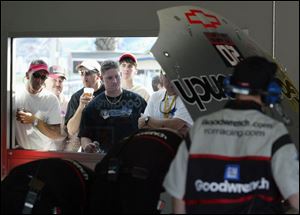
Changing of the sod: Daytona infield reshaped to benefit the fans
2/19/2005DAYTONA BEACH, Fla. - Richard Petty remembers the days when 25,000 people came to see the Daytona 500, and that made it the biggest stock car race in the world. He recalls a wide open and mostly barren infield area that could have been used to graze cattle, and garages that looked like tin-roofed shacks.
The sport has since exploded, the race has grown to where the grandstands seat 168,000, but the infield was still a bit like pasture on non-race days, save for a few buildings, fences and driveways.
Then, following the Pepsi 400 last July, Daytona International Speedway brought in the bulldozers, the brick masons and the landscapers. Seven months later, a chunk of the 180-acre infield has been converted into a fan-friendly amusement park of sorts, and the spectators at this year's Daytona 500 are giving it a proper baptism.
"This brings the fans closer, and it gives them an experience like they've never had, I'm sure," Petty said. "They didn't really have to do all of this stuff, because the fans seem to come no matter what, but it shows the commitment to the fans, and making their experience at the track the best."
The multimillion dollar renovation includes a unique park-like Fan Zone that offer a variety of entertainment on large stages, along with roving jugglers and stilt-people. There is an elaborate open-air bistro in the middle of the fan area, where the drinks and table fare are more upscale than your standard racetrack offerings. You can have a martini with your crab cakes and chocolate mousse, if a Bud and a hot dog don't work.

When Benny Parsons, who won the Daytona 500 in 1975, first went to Daytona as a spectator in 1963, he wanted to get a look at the garage area but couldn't. Now fans will be able to see the inner-workings of the race teams and watch pit stops.
The biggest hit on the renovation list appears to be the re-worked garage areas. The Nextel Cup and Busch Series garages are all new, with race-viewing platforms on top where fans can look right down into the pits, watch the races and the observe the activity in the garages.
The fans who purchase the special infield Fan Zone tickets have access to the back wall of the garages, where huge glass panels allow them to watch up-close as Dale Earnhardt Jr. discusses adjustments to his car with the crew chief, and the No. 8 crew tears into the car.
"It's a little different, with all of those people pressed up against the glass looking in there," Earnhardt said. "Kind of makes you feel a little like the monkeys in the zoo with everybody staring at you, but I guess it's a good thing for the fans -it gets them close. It's a little distracting though, if they start banging on the glass to get your attention."
The pre-race inspection stations that all vehicles in NASCAR races pass through are new, open on three sides, and positioned next to the fan area so racing enthusiasts can eyeball the activity from a few feet away.
"I think this sport has set itself apart from others with the fact that fans can be so close and see the inner-workings of the race teams and watch pit stops," Cup driver Jimmie Johnson said. "When you go to a football game, you can't really see strategy playing out and what's going on in the huddles. Where at this racetrack you see the pit stops, you see the mistakes, and you see the good moves.
"Daytona is our biggest event, and maybe the reason these changes have taken place is that this is the home of NASCAR and we want to have the most modern, state of the art and beautiful facility here."
Other changes to the Speedway infield include the construction of a second tunnel under the track to relieve congestion and accommodate the fleet of large trucks and trailers that need to get to the infield. There is also a large stage for television and radio broadcasts, an interactive walk of fame that pays tribute to the great racers in the track's history, and the posh Daytona 500 Club, which overlooks victory lane and has almost 600 seats that are priced from $2,500 to $5,000 for the season.
Nextel Cup veteran Joe Nemechek, a Florida native, said the drivers have a special sense of pride in seeing the Daytona International Speedway go to great expense to improve the fans' experience.
"This place is so rich in tradition and prestige, and what they've done with the infield and the garage areas is just awesome," Nemechek said. "I really have to applaud everyone involved in making this happen."
Benny Parsons, the 1975 Daytona 500 champion, said he is glad to see the dirt pushed around, the fences moved, and the fans brought inside the whole operation.
"I was first here in 1963 as a racing fan, and I didn't know a soul," Parsons said. "I wanted to get close and look inside the garage area so bad I couldn't stand it. About the only thing you could do was hang on the fence and catch a glimpse here and there - and I did that for 10 days. Now, they've made it a lot easier to see what's going on."
Race day passes to the Fan Zone run $85 in addition to the cost of admission to the Daytona 500, which starts at just under $200. On non-race days, the Fan Zone passes cost $20.
Contact Matt Markey at:
mmarkey@theblade.com
or 419-724-6510.